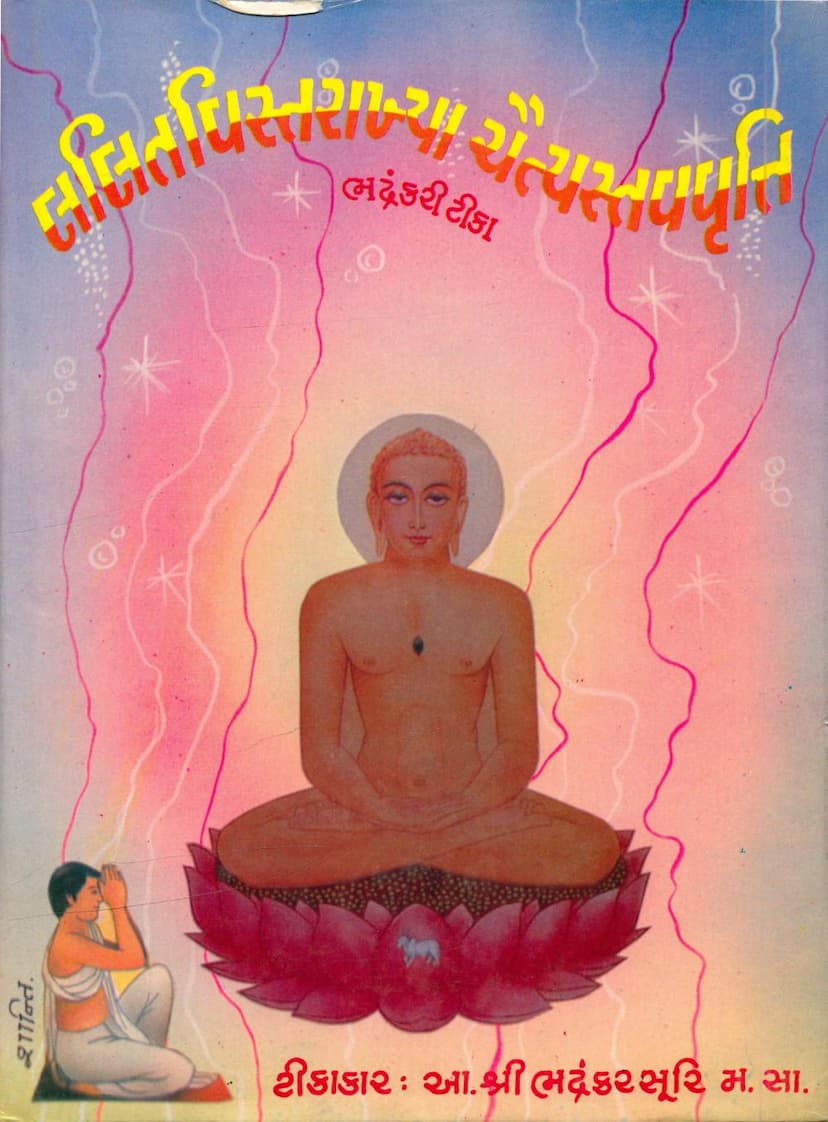Lalit Vistarakhya Chaitya Stavvrutti
Added to library: September 2, 2025

Summary
The provided text is a Marathi or Gujarati translation and commentary on the Jain text "Lalitavistarakhya Chaitya Stavvrutti," authored by Acharya Shrimadvijay Bhadrankarsurishwarji Maharaj and edited by Munivaray Shri Vikramsenvijayji MV. The text is published by Bhuvan Bhandarkar Sahitya Prachar Kendra. The provided content includes introductory pages, a preface, a detailed section on the author and his spiritual lineage, a discussion of the significance of Chaityavandana, and an extensive commentary on the "Namosthun" sutra, along with other related philosophical discussions within Jainism.
Here's a breakdown of the key themes and information presented in the text:
1. The Author and His Lineage:
- Acharya Shrimadvijay Bhadrankarsurishwarji Maharaj: He is described as a highly influential and learned Jain monk, renowned for his scholarship, eloquence, and contributions to the Jain faith. He is referred to by titles such as "Kantikesari," "Shravasti Tirthoddharak," and "Konkan Uddharak," highlighting his widespread impact and spiritual prowess.
- Background: Born in Chhani, Gujarat, in 1973 (Vikram Samvat), his parents were Maniben and Shivalal. From a young age, he harbored dreams of a spiritual life. He took initiation in 1989 (Vikram Samvat) under the guidance of P.A. Labdhisuri Maharajsaheb and became a disciple of P.A. Bhuvanatilaksuri Maharajsaheb.
- Scholarly Achievements: He was known as "Pandit Maharaj" within the community. He mastered Sanskrit, logic, grammar, and poetry. He wrote extensive commentaries on profound spiritual works like "Adhyatmasar" and "Adhyatmopanishad" by P. Yashovijayji MV, and importantly, a detailed commentary on Acharya Haribhadra Suriji's "Lalitavistara." He also translated and elucidated several Agama and philosophical texts into Gujarati.
- Spiritual Leadership: He held prestigious positions such as "Gachhadhipati" and "Acharya," travelling extensively and spreading the influence of Jainism. He played a significant role in the revival of Shravasti, a sacred pilgrimage site.
2. The Text "Lalitavistarakhya Chaitya Stavvrutti":
- Significance: The book is presented as a highly anticipated, invaluable, and unique literary gem that fulfills the spiritual aspirations of scholars, logicians, and philosophers.
- Context: It addresses the increasing difficulty in studying classical Sanskrit texts, making the study of complex philosophical and logical works in Sanskrit even more challenging. The commentary is seen as a bridge to understanding these profound texts.
- Core Message: The text focuses on the "Chaitya Stav" (veneration of temples/Jina images) and its underlying principles. It emphasizes that true knowledge is that which leads to self-realization.
- Commentary on "Lalitavistara": The "Lalitavistara" itself is a commentary on the "Chaitya Stav Sutras," authored by Acharya Haribhadra Suriji. Haribhadra Suriji's commentary is considered a masterful blend of devotion (Shraddha) and logic (Tarka).
- Structure and Content: The book delves into the intricacies of the "Namosthun" (Namuṭṭhaṇam) sutra, explaining its 33 epithets for the Tirthankara Parmatma. It explores the profound secrets hidden within each verse, demonstrating the superiority of Jainism and the concept of Tirthankaras as benefactors to all beings. The commentary also addresses philosophical debates with other schools of thought, highlighting the strength of Jain logic.
- Panjika: The text mentions a "Panjika" (brief commentary) on the "Lalitavistara" by Acharya Shrimad Munichandrasuri, which further clarifies the complex explanations of Haribhadra Suriji.
3. Key Jain Concepts Discussed:
- Chaityavandana: This is presented as a crucial daily ritual for monks and nuns, and a foundational practice for the Jain community. It is described as a means to counteract false perceptions and purify right perception.
- Bhavana (Sentiments/Meditations): The text stresses the importance of performing Chaityavandana with pure sentiments (bhava) rather than mere external ritualistic actions (kolahal).
- Tirthankara Parmatmas: Their role in establishing the Dharma-tirth (path of righteousness) for the salvation of all beings is highlighted. Their profound compassion, selfless actions, and unique karmic qualities that lead to Tirthankara status are discussed.
- Karma and Moksha: The text implicitly touches upon the concept of karma and its eradication for achieving liberation (moksha) through diligent spiritual practice and adherence to dharma.
- Shraddha and Tarka: The commentary by Haribhadra Suriji is praised for its successful integration of devotion (shraddha) and logic (tarka), showing they are not mutually exclusive but complementary paths to understanding truth.
- The Importance of Knowledge: The text repeatedly emphasizes that true knowledge, derived from scriptures and spiritual practice, is essential for correct understanding and meaningful ritual.
- The Role of Virtuous Souls: The text celebrates the legacy of great Jain Acharyas like Haribhadra Suriji and Munichandrasuri, highlighting their dedication to preserving and disseminating spiritual knowledge, even in challenging times.
- The "Lalitavistara" as a Guide: The commentary on "Lalitavistara" is presented as a guide to understanding the profound meanings and benefits of Chaityavandana, inspiring both regular performers and those yet to embrace the practice.
4. Specific Sutras and Concepts Elaborated: The text details the philosophical depth of various sutras within Chaityavandana, including:
- Namosthun (Namuṭṭhaṇam): Each of its 33 epithets is analyzed.
- Arihant Cheiyanam: The veneration of Jain temples and deities.
- Logassa: A significant sutra within Chaityavandana.
- Puspakara Sutra, Siddha Sutra, Vaiyavachya Sutra, Jayaviyaraya Sutra: These are mentioned as being part of the extensive commentary, indicating a comprehensive treatment of the sacred texts.
5. Publisher and Publication Details:
- Publisher: Bhuvan Bhandarkar Sahitya Prachar Kendra.
- Part of a Series: It is part of the "Shri Bhuvanatilkasuri Granthamala - 54."
- Supporting Organizations: The publication acknowledges support from various Jain Sanghs and individuals, reflecting the community's commitment to preserving and disseminating religious literature.
In essence, "Lalitavistarakhya Chaitya Stavvrutti" is a monumental work that provides a deep dive into the philosophical and devotional aspects of Jain Chaityavandana, illuminated by the profound scholarship and spiritual dedication of Acharya Shrimadvijay Bhadrankarsurishwarji Maharaj. It serves as a vital resource for understanding Jain rituals, logic, and the path to spiritual liberation.